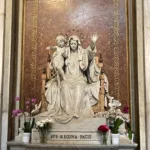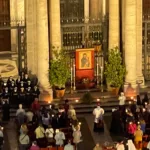
 Vincent Reilly, Managing Director of Faith, Family and Discipleship for the Diocese of Greenburg, is one of 20 people in Rome as part of Notre Dame’s Mathis Liturgical Leadership Program. While in Rome, he will be working with his counterparts from around the United States to develop ways to bring Eucharistic Revival back to parishes here in the Diocese and across the country.
Vincent Reilly, Managing Director of Faith, Family and Discipleship for the Diocese of Greenburg, is one of 20 people in Rome as part of Notre Dame’s Mathis Liturgical Leadership Program. While in Rome, he will be working with his counterparts from around the United States to develop ways to bring Eucharistic Revival back to parishes here in the Diocese and across the country.
Information gleaned from this trip will be built out over the next year and a half with methods of forming people in the eucharistic life in the church. Follow Vincent’s journey in his daily blog below.
DAY ONE:
To begin the Eucharistic Revival pilgrimage in Rome with the Mathis Liturgical Leadership Program with the University of Notre Dame, we visited the Major Basilica of Santa Maria Maggiore to dedicate this week to the Blessed Mother. Originally built in the fifth century and remodeled a few times including during the Counter Reformation, this Basilica is the principal Church dedicated to Mary in the world. The location of the Church is at the opposite end of the Via Meruluna from the Basilica of St. John Lateran which is dedicated to Christ our Savior. Visible to one another is a reminder of “To Jesus through Mary” and processions in the Roman Church would often take place between the two Churches when Christ would save the Romans from plague or war.
The Basilica of St. Mary Major is lavishly covered in gold mosaic telling the story of salvation in the Bible. The gold actually came from Columbus’ conquest of Puerto Rico. Below the main altar is the relics of Jesus’ manger brought back from Bethlehem. These relics remind us that it is through Mary’s “yes” to the Incarnation that Jesus lived within her so that he might live within us in the Eucharist.
Similarly, the Basilica design traces back to pre-Christian times when the sacred work of the elders was done at the front of the Church, while common business was conducted in the central part of the basilica that would be brought out and shared with the world. The gifts of bread and wine we use at the Eucharist are brought forward from the people to be changed into the Body and Blood of Christ which we then receive in the main body of the Church, which we are then called to share in the world through our lives. The basilica reminds us that the Eucharist we celebrate in the Church is to be lived out in the community. We were able to celebrate evening prayer with the basilica in the square, which invited passersby to stop and pray with the Church.
Benedizioni,
Vincent
DAY TWO:
Today, we began our day early at the Pantheon, which was made a Church in 609AD and dedicated to Mary and all martyrs. On Pentecost, the oculus of the Church is used by the firefighters of Rome to rain down thousands of rose petals on the assembly as the traditional chant of Veni Sancte Spiritus is sung. Mass was celebrated by Cardinal Sean O’Malley of Boston who met with our group following the Mass.
The most beautiful part of the rose ceremony was the joy and anticipation of the children (and some adults) waiting for the roses to fall. The children were encouraged to play in the roses and celebrate the descent of the Holy Spirit. If only we were as joyful and playful in Church to have a childlike encounter with the Lord in the Eucharist!
We then journeyed to Subiaco, where St. Benedict founded the Benedictine rule. It is the oldest continuously running Benedictine monastery in the world. We were able to see the cave in which Benedict sought solitude and order. St. Francis of Assisi lived there as well to seek inspiration to form the Franciscans. The cave has the oldest contemporary painting of Francis.
To get to the monastery, we had to hike up a road on a pilgrimage. The movement of pilgrimage reminded me of the road to Emmaus in which it was on the journey that disciples can have an encounter with the Risen Lord. New to my reflection on the road to Emmaus was the encounter of Christ in the other disciples. We need one another to get to the destination in which we were going, just as Benedict needed his brothers and not the hermitical life to establish the Benedictine community and reach sainthood. We need one another to celebrate the Eucharist and recognize Christ’s presence fully.
Benedizioni,
Vincent
DAY THREE:
Today, we headed back to Rome to continue the Benedictine portion of our pilgrimage to visit St. Paul Outside the Walls, the second of the four major papal basilicas. St. Paul is built on the tomb of the missionary to the Gentiles who was beheaded during the persecutions after the great Roman fire of 64AD. Paul’s body was discovered in a sarcophagus during the excavations near the Church in 2002. The Church was built on the major road connecting the main port to the city of Rome. The basilica has been entrusted to the Benedictine order since 937. The Church contains the official chronology of all the popes tracing back to Peter.
We then journeyed to the Roman Forum, visiting the Via Sacra, which Peter and Paul would have both travelled. We visited the Basilica of Cosmos and Damien, early Roman martyrs, then passing by the Colosseum, went to the Basilica of St. Clement. St. Clement is cared for by the Dominicans, who during World War II excavated the basilica, discovering two Churches beneath the ground. Connecting with the theme of missionary discipleship, we saw the baptismal pool where Sts. Cyril and Methodius were commissioned to evangelize the East.
The reminder that the Eucharist calls us to go evangelize was key to this day. Building a Eucharistic culture requires us to sacrifice all for others, whether through physical martyrdom or through the daily sacrifice of self, made every day. In the Eucharist, not only the sacrifice of the cross is offered, but also our own particular sacrifices are joined with Jesus’ on the altar. The need to preach the Gospel, of sharing our particular encounter with Christ, takes us beyond our comfort zone and allows us to share our lives with others. May we always desire to become broken for others as we share our story and our lives with those God places in our path.
Day 5
Today we explored the lives of St. Dominic and St. Ignatius of Loyola. In visiting Sancta Sabina, we explored Dominic’s home where he would pray and promote the Rosary. He would encourage his religious order to preach the Gospel powerfully in order to lead people to the Truth of Christ. St. Catherine of Siena, who was a third order Dominican and St. Thomas Aquinas, a Dominican priest provided the Eucharistic spirituality for the Order. Catherine would live on only the Eucharist and was considered miraculously fat where her incorrupt body at Sancta Maria sopra Minerva still testifies to this miracle. Her close relationship with Christ that led to other miracles is rooted in her experience of the Eucharist. Thomas wrote the great Eucharistic hymns for the feast of Corpus Christi.
Moving from St. Dominic, we journeyed to the Jesuit churches of the Gesu and Sant’Ignazio. At the Gesu, we visited Ignatius’ apartment where he lived in Rome and where he died. Ignatius founded the Jesuits to combat the denial of the true presence of Christ in the Eucharist during the Protestant Reformation. Many Jesuit saints are buried in the Gesu and the ceiling is decorated beautifully, drawing crowds in to the Church to marvel, having seen the images on TikTok. We then finished our day at the Church of Sant’Ignacio to see the body of St. Ignatius and the machina celebration that happens each night that tells the story behind Ignatius’ death.
Seeing these Churches today made clear that we are connected with the lives of the saints in the Eucharist and that their witness to the Eucharist have preserved the devotion throughout history. The importance of evangelizing others with strong preaching and art is key to the Eucharistic Revival.
Day 6
Our final day in Rome was spent like most pilgrims who would journey to the city throughout Christianity, visiting St. Peter’s Basilica. We started early with Mass in the choir chapel over the tomb of St. John Chrysostom, followed by a tour of the cathedral. We were able to pray at the tombs of many popes, including John Paul II, Benedict XVI, and Peter himself. Just as Paul sends the Church out on mission, Peter gathers the Church together as one. The relics of St. Peter are under the papal altar which is in front of the image of the Holy Spirit shining forth into the Basilica. From the altar, one can see deep into the city of Rome and the world, where the pope blesses all God’s people. The size of this Basilica is to remind us of the gathering of the nations and having the space necessary to allow all to be gathered in. From the Basilica and the grotto, we journeyed up to the top of the dome for panoramic views of Rome and the surrounding areas.
After our visit to the Basilica, we toured the Vatican Museums and the Sistine Chapel. Newly opened since Covid, we able to view the original statue of Christ the Good Shepherd that was carved as part of an ossuary of an early Christian. We then were able to have the famous paintings of the masters virtually to ourselves to pray with and see the Eucharistic imagery. Finally, we were able to journey to spend time in prayer in the Sistine Chapel, in which the popes are elected by the Cardinals and experience Michaelangelo’s beautiful ceiling and last judgment altarpiece.
The Eucharistic Revival is calling for us to gather the nations to join at the table of the Lord. From the mass of crowds, it was abundantly apparent that there is still a hunger for experiencing Christianity with its art, architecture, and worship. The straw is dried out and is waiting for the match to set the fire ablaze. As our cohort with the Mathis Liturgical Leadership Program finishes our time in Rome, we ask ourselves, “What resources and inspirations are needed to light this flame of Eucharistic culture brazenly in the United States and around the world?” May this pilgrimage be a source of desire for us all to have a deeper encounter with our Eucharistic Lord, who is worth the festivity and joy of experiencing his presence at every Mass!
- Tags:
RELATED STORIES

Catholic Daughters of the Americas, Court St. Bernard Education Contest Awards

Sister Mary Jean Petrarca, SC, age 91, entered eternal life April 19, 2024 in her 72nd year of religious life

Cardinal: Vocation is call to happiness; right path is discerned in prayer

Catholics Participating in National Eucharistic Pilgrimage and the National Eucharistic Congress Have Opportunities to Receive Plenary Indulgences

New Survey of Men Being Ordained to the Priesthood Underscores the Significant Influence of Parents on Children’s Vocational Discernment

Sister Grace Snyder, a Sister of Saint Francis of the Neumann Communities – Millvale, after 76 years of religious life.

Diocese, Saint Vincent Seminary's IMF partner for formation program

Geibel Catholic's Bell marks 25 years of musicals

At Aquinas Academy, teamwork turns trash into treasure















